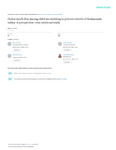Ocular morbidity among children studying in private schools of Kathmandu valley: A prospective cross sectional study.
| dc.contributor.author | Shrestha, RK | |
| dc.contributor.author | Joshi, Mahesh Raj | |
| dc.contributor.author | Ghising, R | |
| dc.contributor.author | Pradhan, P | |
| dc.contributor.author | Shakya, S | |
| dc.contributor.author | Rizyal, A | |
| dc.date.accessioned | 2020-09-15T08:57:49Z | |
| dc.date.available | 2020-09-15T08:57:49Z | |
| dc.date.issued | 2006-03 | |
| dc.identifier.issn | 2676-1319 | |
| dc.identifier.issn | 2676-1424 | |
| dc.identifier.uri | http://hdl.handle.net/10026.1/16313 | |
| dc.description.abstract |
A prospective cross sectional study of students of two private schools was done and students were screened in detail. A total of 1816 students aged 5 to 16 years were evaluated, out of which 52.8% were males and 47.2 % were females. Among the total, 65.8% had no ocular abnormalities and 34.2% had some form of ocular disorders. Refractive error was the commonest problem seen accounting for 21.9% out of total, followed by infective disorders, which accounted for 7.2%, 3.5% of them were noted to have Orthoptic problem including various types of strabismus, 2.2% were color blind, 2.6% were found to have various other disorders. The prevalence of refractive error among private school children seems to be higher. Color blindness also seems to be prevalent among these children. This kind of school screening would help in detecting the eye problems timely and thus would reduce the ocular morbidity as well as prevent children from going blind unnecessarily. | |
| dc.format.extent | 43-46 | |
| dc.format.medium | ||
| dc.language | eng | |
| dc.language.iso | eng | |
| dc.subject | Adolescent | |
| dc.subject | Child | |
| dc.subject | Child, Preschool | |
| dc.subject | Cross-Sectional Studies | |
| dc.subject | Female | |
| dc.subject | Humans | |
| dc.subject | Male | |
| dc.subject | Morbidity | |
| dc.subject | Nepal | |
| dc.subject | Prevalence | |
| dc.subject | Private Sector | |
| dc.subject | Prospective Studies | |
| dc.subject | Public Sector | |
| dc.subject | Refractive Errors | |
| dc.subject | School Health Services | |
| dc.subject | Vision Disorders | |
| dc.subject | Vision Screening | |
| dc.title | Ocular morbidity among children studying in private schools of Kathmandu valley: A prospective cross sectional study. | |
| dc.type | journal-article | |
| dc.type | Journal Article | |
| plymouth.author-url | https://www.ncbi.nlm.nih.gov/pubmed/16827090 | |
| plymouth.issue | 1 | |
| plymouth.volume | 8 | |
| plymouth.publication-status | Published | |
| plymouth.journal | Nepal Med Coll J | |
| plymouth.organisational-group | /Plymouth | |
| plymouth.organisational-group | /Plymouth/Faculty of Health | |
| plymouth.organisational-group | /Plymouth/Faculty of Health/School of Health Professions | |
| plymouth.organisational-group | /Plymouth/REF 2021 Researchers by UoA | |
| plymouth.organisational-group | /Plymouth/REF 2021 Researchers by UoA/UoA03 Allied Health Professions, Dentistry, Nursing and Pharmacy | |
| plymouth.organisational-group | /Plymouth/Users by role | |
| plymouth.organisational-group | /Plymouth/Users by role/Academics | |
| dc.publisher.place | Nepal | |
| dc.identifier.eissn | 2676-1424 | |
| dc.rights.embargoperiod | Not known | |
| rioxxterms.licenseref.uri | http://www.rioxx.net/licenses/all-rights-reserved | |
| rioxxterms.type | Journal Article/Review |


